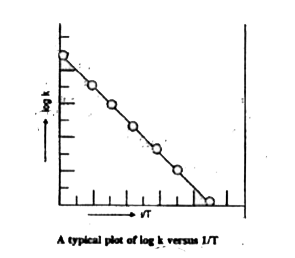How is rate constant of a reaction related to its activation energy?Solution in Punjabi
Arrhenius (1889) developed a mathematical relationship between temperature and the rate constant on the basis of the observations from the large number of experiments. The temperature dependence of the rate constant, k is expressed algebraically as follows.
k∝e−Ea/RT
k=Ae−Ea/RT

This equation is known as Arrhenius equation. Here, A is a constant of proportionality and is known as frequency factor:-This-factor is related to the number of binary molecular collisions per second per litre. E is the activation energy, R is gas constant and T is the absolute temperature. Taking logarithm, egn. (1) may be written as ,
In k=In A+ In e−Ea/RT
In k=In A-EaRTIne
In k=InA−EaRT [∵In e=1] ...(ii)
Converting to common logarithm, we get
logk=logA−Ea2.303R1T ... (iii)
or logk=−Ea2.303R1T+logA
This equation is of the form y = mx + ci.e., the equation of a straight line. Thus, if a plot of log k versús 1/T is a straight line, the valdity of the equation is confirmed. From eqn: (lin) we havė,
Slope of the line = Ea2.303R
Thus, by knowing the value of the slope and gas constant R, the activation energy E can be calculated.
Alternatively, Ea, can be determined by using another form of the Arrhenius equation in which A is eliminated. This is because frequency factor A cannot be determined accurately for the reactions. From eqn. (iii)
In k=In A-EaRT
In k = In k1 and k2 are the values of rate constants at temperatures T1 and T2, then,
In k1=InA−EaRT1 ...(iv)
and Ink2=InA−EaRT2
In Subtracting eqn. (iv) from egn. (v), we get
In k2-In k1=−EaRT2−−EaRT1
In k2−Ink1=EaRT1−EaRT2
In k2k1=Ea2.303R[T2−T1T1T2]
Converting to common iogarithm,
log k2k1=Ea2.303R[T2−T1T1T2]
Topper's Solved these Questions
- CHEMICAL KINETICSBOOK - BETTER CHOICE PUBLICATIONCHAPTER - CHEMICAL KINETICSEXERCISE - Numerical Problems
63 Videos
- BIOMOLECULES BOOK - BETTER CHOICE PUBLICATIONCHAPTER - BIOMOLECULES EXERCISE - QUESTION BANK
85 Videos
- CHEMISTRY IN EVERYDAY LIFEBOOK - BETTER CHOICE PUBLICATIONCHAPTER - CHEMISTRY IN EVERYDAY LIFEEXERCISE - QUESTIONS
76 Videos
Similar Questions
The rate constant of a reaction is 1.5×107sec−1 at 50∘C and 4.5×107sec−1 at 100∘C. Calculate energy of the activation for the reaction.
View SolutionCovalent compounds are soluble in
View SolutionWhat is a medicine ?
View SolutionThe activation energy of a reaction is zero. The rate constant of this reaction
View SolutionWhat is the relation between rate constant and activation energy of a reaction?
View Solutionwhat is the activation energy? How is rate constant related to activation energy?
View SolutionHow is rate constant of a reaction affected by temperature ? Write the name of this relation. How will you calculate activation energy of a reaction with the help of this relation ?
View SolutionThe activation energy of a reaction is zero. The rate constant of this reaction
View SolutionThe activation energy of a reaction is zero . The rate constant of the reaction :
View Solutionएक अभिक्रिया की सक्रियण ऊर्जा शून्य है। इस अभिक्रिया के लिए दर स्थिरांक
View Solutionएक अभिक्रिया की सक्रियण ऊर्जा शून्य है। इस अभिक्रिया के लिए दर स्थिरांक
View SolutionThe activation energy of a reaction is zero. The rate constant of this reaction
View SolutionWhat is the relation between rate constant and activation energy of a reaction?
View SolutionHow is energy of activation related to rate constant of a reaction?
View SolutionHow is energy of activation related to rate constant of a reaction ?
View SolutionThe activation energy of a reaction is zero. The rate constant of this reaction
View Solution
